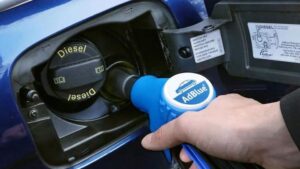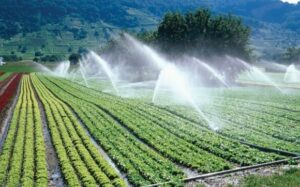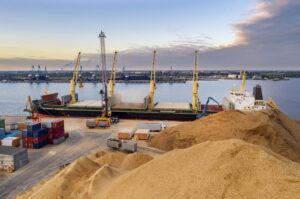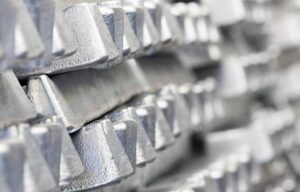
Production of AdBlue, a special additive for diesel engines used to reduce NO (nitrogen oxide) emissions, was launched by Ostchem on the basis of Cherkassy Azot
“Today, Cherkassy Azot is capable of producing volume that provides 80% of the Ukrainian market and, if necessary, can ramp up production to cover all domestic consumption and for export to EU markets,” the company said in a press release on Friday.
It is specified that the market volume in Ukraine in 2022 was 23.4 thousand tons, and it decreased by more than 10 thousand tons due to military actions. Growth potential of Ukrainian market after introduction of standard Euro-4, Euro-5, Euro-6 exceeds 250 thousand tons, as the company believes.
Project on AdBlue production at Cherkassy “Azot” was announced in February 2022, in May 2022 the plant began to produce the first batches of product, and today the volume of urea solution production accounts for 30% of Ukrainian market needs.
“We are capable of becoming a major national player and gradually displacing imports. Our plans are to become a strong player in the EU markets, where demand for AdBlue is at a high level,” said Sergey Pavlyuchuk, head of Ostchem’s nitrogen business.
According to the release, the new production facility passed an international audit and this week received all required certificates confirming the quality of the product and allowing to use the AdBlue trademark and enter the EU markets, where, according to Ostchem, Ukrainian AdBlue has good prospects.
It is stated that at the first stage the company intends to fill the Ukrainian market by planning wholesale sales of AdBlue directly from the facility, as well as sales through retail chains, service stations and petrol stations and is already negotiating with a number of petrol stations to install their own AdBlue stations.
According to Ostchem, a large consumer of AdBlue will also be the agro-industrial complex, which uses modern machinery of the new generation.
A separate direction will be sales of the product in small containers of 10 and 20 liters.
The second stage will involve export to the neighbouring EU countries – Lithuania, Latvia, Romania, Hungary and Poland, as well as major AdBlue consumers – Germany (consumption level of 2.4 m t/year), France (2.1 m t/year), Italy (1.3 m t/year) and Turkey (726,000 t/year). According to Group DF estimates, the European market volume exceeds 7.2 million tons per year.
It is also stated that Cherkasy Azot will be the only Ukrainian producer of AdBlue by “direct method”, i.e. method of urea melt production, while the other producers use so called “blending” method, i.e. technology of mixing granulated urea with water. According to the company, its method ensures very high and stable quality at a low price, and in order to distinguish its AdBlue reagent on the Ukrainian and European markets, Ostchem has already registered its own trademark “Ukrblue”.
The use of the reagent is stipulated by EURO 6 standards and is aimed to reduce emissions of harmful substances. VDA (Verband der Automobilindustrie e.V., German Automotive Industry Association) owns the rights to the AdBlue trademark.
Group DF consolidates assets in the gas distribution, chemical, titanium and port industries, as well as in agriculture and media. The founder and owner of Group DF is Ukrainian businessman Dmitry Firtash.
Ostchem is the nitrogen holding of Group DF. It includes Rivneazot, Cherkasy Azot, as well as Severodonetsk Azot and Stirol (not operating and located in the occupied territories).
Cherkasy Azot PJSC has been a part of Group DF since 2011. The design production capacity of PJSC “Azot” is 962.7 thousand tons of ammonia per year, ammonium nitrate – 970 thousand tons per year, urea – 891.6 thousand tons, UAN – 1 million tons per year.

Agro-industrial holding Astarta, the largest sugar producer in the country, has expanded its irrigated area up to 1 thousand hectares and purchased five sprinklers, the company said on Facebook.
“The project is implemented in the IPK “Poltavazernoprodukt” Astarta-Kyiv Ltd. To the three sprinkler machines were added five more. For this purpose, we purchased four more frontal machines and one circular machine, in order to maximally cover the planned area with irrigation”, – said the agricultural holding.
The new sprinklers have already been put to work on the fields with sugar beets and hybrid corn. There are 14 hydro technicians working in shifts to maintain the machines. Water for irrigation is supplied by Poltava Regional Water Resources Office. To supply it to the fields, the agricultural holding restored and additionally laid about 10 km of communications, explained in “Astarta”.
Restoration of the irrigation system in the agrofirm began back in 2015 on an area of 300 hectares with drip irrigation.
“Currently, the project has been successfully implemented, despite all the economic difficulties and the war,” summarized in the agricultural holding.
“Astarta” is a vertically integrated agro-industrial holding operating in eight regions of Ukraine. It consists of six sugar factories, farms with land bank of 220 thousand hectares, dairy farms with 22 thousand cattle, oil extraction plant in Globino (Poltava region), seven elevators and biogas complex.
Agricultural holding in 2021 increased net profit 14 times compared with 2020 – up to EUR 122.5 mln, EBITDA – 1.8 times, up to EUR 201.5 mln. Its revenue increased by 18.2% – to EUR 491.35 mln, one third of which (EUR 170 mln) was generated by sugar production and sales.

“Grain Initiative” is already operating at less than 20% of its normal throughput capacity because of the Russian Federation’s position in the joint coordination center and the situation is getting worse every day, Deputy Infrastructure Minister Yuriy Vaskov told Interfax-Ukraine in a commentary on Thursday.
“We have had only 43 vessels inspected for entry since May 1 until today. Accordingly, on average, since May 1, the Russian Federation has let in a little more than one vessel per day for inspection. Fifty-four vessels are currently awaiting inspection, some of which have been awaiting inspection for more than three months. The port of Pivdenny is not fully operational. If we talk in numbers, the initiative is already working at less than 20% of its normal capacity. And the situation is deteriorating day by day, solely because of Russia’s position in the joint coordinating center,” said Vaskov.
The deputy minister pointed out that the UN and Turkey are informed of the situation and negotiations are being conducted through them. “Negotiations are being conducted through the UN and Turkey. They are aware of the situation. Every day we communicate. At this time, we have no information that the situation can improve,” Vaskov said.
Answering the question about the prospects for Russian ammonia transit in exchange for guarantees of normal functioning of the secure grain export agreement, he recalled that the ammonia pipeline is currently non-operational. “The ammonia pipeline has been damaged twice in the last three days by Russian shelling. At the moment it is inoperable. To say how long it can be repaired, only the relevant specialists will be able to say when they get access and it is safe,” Vaskov said.
“The Black Sea Grain Initiative was adopted in Istanbul on July 22, 2022 with the participation of the UN, Ukraine, Turkey and Russia. Its essence is to create a corridor for the export of grain from the three Ukrainian ports “Chernomorsk”, “Odessa” and “Pivdenniy” in the conditions of Russia’s ongoing war against Ukraine. The initiative was concluded for 120 days and was extended twice, most recently on March 18. However, while Ukraine claimed it had been extended for 120 days, Russia claimed only 60, until May 18, and insisted on unblocking the operation of the Tolyatti-Odessa ammonia pipeline and lifting all sanctions on trade in Russian agricultural products and fertilizers.
On May 17, Turkey’s president said that the Grain Initiative would continue for two more months, which was later confirmed by UN Secretary General Antonio Gutteres. However, the head of the UN said that there were still unresolved issues.
The port of Pivdenniy is operated by the Odessa Port Plant, which is engaged in the transshipment of ammonia from the Tolyatti-Odessa ammonia pipeline.

The All-Ukrainian Agricultural Rada (AAR) and the Association of Milk Producers (AMP) will hold a mirror strike in response to the protest started by Polish farmers against the transit of Ukrainian agricultural products through Poland and will not allow Polish trucks into Ukraine.
“In protest against the actions of Polish agricultural producers who began a strike and blocked the border crossing point (BCP) “Dorohusk – Yagodin” for cargo with Ukrainian grain, domestic agricultural producers decided to act in the mirror,” – noted in a press release of the WAR.
It is emphasized that Ukrainian agrarians have taken a strong stance to protect their interests and the domestic agricultural sector. During the strike, they will block the movement of Polish trucks through four international checkpoints, viz: The checkpoint “Dorogusk – Jagodin” on the Ukrainian side, in the municipality of Krakivets near the checkpoint “Krakivets-Korcheva”, in the village of Rata near the checkpoint “Rawa-Russkaya” and in the village of Shehini near the checkpoint “Shehini-Medika”.
The action will begin on June 10 at 10:00 and will last until 00:00, June 14.
As reported, for several days, Polish farmers have been blocking the PP “Dorohusk – Jagodyn” in protest against the influx of Ukrainian grain to the Polish market.
Only vehicles carrying humanitarian aid are allowed to pass. As part of the protest, two trucks with humanitarian aid will pass from Poland to Ukraine per hour, and none from Ukraine to Poland.
According to data for Friday morning, about 320 heavy trucks stood in a nine-hour queue to leave Poland for Ukraine at the Dorohusk border crossing point. According to the Ukrainian side, there were 3,185 trucks registered in the electronic queue to enter Poland.
The Polish protest is expected to last until midnight on Monday.

According to customs statistics released by the State Customs Service of Ukraine, the export of aluminum and aluminum products in January-May this year increased by 0.7% compared to a year earlier – to $39.735 million (in May – $8.306 million), lead and aluminum products decreased by 17.2% – to $6.684 million ($1.214 million).
Exports of aluminum and aluminum products for 2022 decreased 42.7% from 2021 to $96.972 million, lead and lead products decreased 68.7% to $11.970 million, and nickel and nickel products decreased 73.9% to $1.268 million.